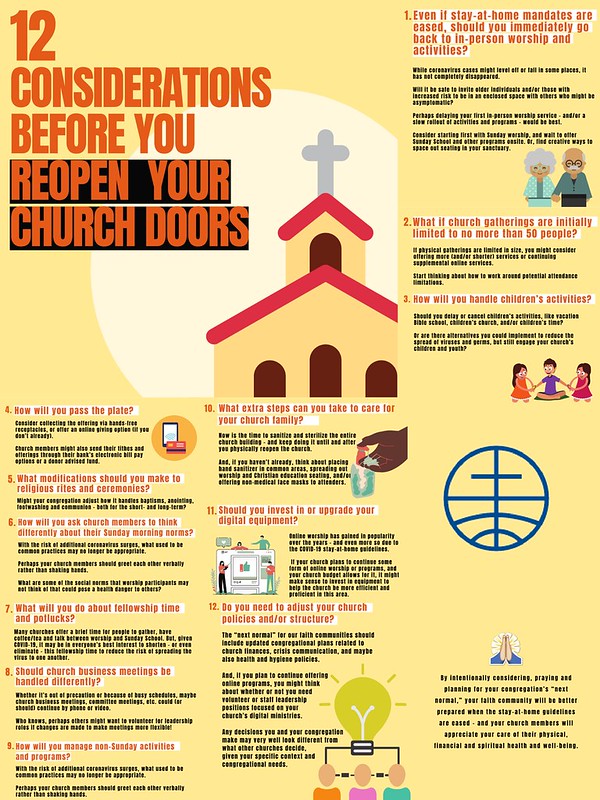When stay-at-home guidelines are eased and church doors and sanctuaries reopen, worship and church ministries will, undoubtedly, look different than before the COVID-19 (coronavirus) outbreak. And so it should – so that we continue to keep ourselves and our faith communities safe and healthy.
But that means pastors and church leaders should prepare for what the “next normal” will be for the congregation and its ministry. The following are some things to consider before inviting congregants back into the (physical) pews.
1. Even if stay-at-home mandates are eased, should you immediately go back to in-person worship and activities?
While coronavirus cases might level off or fall in some places, it has not completely disappeared. Will it be safe to invite older individuals and/or those with increased risk to be in an enclosed space with others who might be asymptomatic? Perhaps delaying your first in-person worship service – and/or a slow rollout of activities and programs – would be best.
Consider starting first with Sunday worship, and wait to offer Sunday School and other programs onsite.
Or, find creative ways to space out seating in your sanctuary – or hold worship outdoors during the warmer summer months.
2. What if church gatherings are initially limited to no more than 50 people?
If physical gatherings are limited in size, you might consider offering more (and/or shorter) services or continuing supplemental online services. Start thinking about how to work around potential attendance limitations.
3. How will you handle children’s activities?
It’s hard for most kids to understand why they need to keep a certain amount of distance between them and their friends. Should you delay or cancel children’s activities, like vacation Bible school, children’s church, and/or children’s time? Or are there alternatives you could implement to reduce the spread of viruses and germs, but still engage your church’s children and youth?
4. How will you “pass the plate”?
Collecting tithes and offerings in a physical plate might no longer be feasible. Consider collecting the offering via hands-free receptacles, or offer an online giving option (if you don’t already). Church members might also send their tithes and offerings through their bank’s electronic bill pay options or a donor advised fund.
5. What modifications should you make to religious rites and ceremonies?
Might your congregation adjust how it handles baptisms, anointing, footwashing and communion – both for the short- and long-term?
6. How will you ask church members to think differently about their Sunday morning norms?
With the risk of additional coronavirus surges, what used to be common practices may no longer be appropriate.
Perhaps your church members should greet each other verbally rather than shaking hands.
What are some of the social norms that worship participants may not think of that could pose a health danger to others?
7. What will you do about fellowship time and potlucks?
Many churches offer a brief time for people to gather, have coffee/tea and talk between worship and Sunday School. But, given COVID-19, it may be in everyone’s best interest to shorten – or even eliminate – this fellowship time to reduce the risk of spreading the virus to one another.
Likewise, the familiar act of sharing a meal or potluck as a community also could put some people’s health at risk. How might your church find safe alternatives for breaking bread together?
8. Should church business meetings be handled differently?
Whether it’s out of precaution or because of busy schedules, maybe church business meetings, committee meetings, etc. could (or should) continue by phone or video. Who knows, perhaps others might want to volunteer for leadership roles if changes are made to make meetings more flexible!
9. How will you manage non-Sunday activities and programs?
From Bible study gatherings, to mid-week activities, to inviting external groups to use your church space – how will you manage everything that happens in your church building during the rest of the week? Creatively plan for these decisions.
10. What extra steps can you take to care for your church family?
Now is the time to sanitize and sterilize the entire church building – and keep doing it until and after you physically reopen the church.
And, if you haven’t already, think about placing hand sanitizer in common areas, spreading out worship and Christian education seating, and/or offering non-medical face masks to attenders.
11. Should you invest in or upgrade your digital equipment?
Online worship has gained in popularity over the years – and even more so due to the COVID-19 stay-at-home guidelines. If your church plans to continue some form of online worship or programs, and your church budget allows for it, it might make sense to invest in equipment to help the church be more efficient and proficient in this area.
12. Do you need to adjust your church policies and/or structure?
The “next normal” for our faith communities should include updated congregational plans related to church finances, crisis communication, and maybe also health and hygiene policies.
And, if you plan to continue offering online programs, you might think about whether or not you need volunteer or staff leadership positions focused on your church’s digital ministries.
Any decisions you and your congregation make may very well look different from what other churches decide, given your specific context and congregational needs. Your denominational leadership may have further guidance and suggestions; also check with the World Health Organization and national, regional and local governments.
By intentionally considering, praying and planning for your congregation’s “next normal,” your faith community will be better prepared when the stay-at-home guidelines are eased – and your church members will appreciate your care of their physical, financial and spiritual health and well-being.
—A Mennonite World Conference release by Madalyn Metzger, vice president of marketing, Everence. This article first appeared on the Everence blog, then on The Mennonite Inc.
